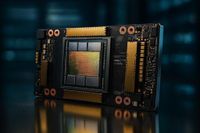On September 18, 2025, China’s technology landscape experienced a seismic shift as the Cyberspace Administration of China (CAC) ordered some of the country’s largest tech companies—including Alibaba and ByteDance—to immediately halt all purchases and testing of Nvidia’s latest high-end AI chips, the RTX Pro 6000D. This move, which stunned both industry insiders and financial markets, signals a new phase in the ongoing tech rivalry between the U.S. and China, and leaves Nvidia, the world’s most valuable semiconductor company, caught squarely in the geopolitical crossfire.
According to Reuters and the Financial Times, the CAC’s directive is far more sweeping than earlier restrictions, which had only discouraged the use of Nvidia’s H20 chips. The RTX Pro 6000D, custom-designed for the Chinese market after U.S. export rules blocked Nvidia’s flagship processors, was supposed to be Nvidia’s answer to the tightening regime. Chinese firms had already begun testing the chips and were preparing to buy tens of thousands of units, working closely with Nvidia’s server suppliers to bring them online. But once the CAC’s order landed in the week of September 15-18, all such plans were abruptly canceled. Suppliers were instructed to cease work immediately, leaving a trail of uncertainty in their wake.
Nvidia CEO Jensen Huang confirmed the ban during a press briefing in London on September 17. As reported by Reuters, Huang expressed his disappointment, stating, “We can only be in service of a market if the country wants us to be.” He went on to acknowledge the broader context: “They have larger agendas to work out between China and the United States, and I’m understanding of that.” Huang’s remarks underscored the sense of resignation felt by many in the industry, as Nvidia’s future in China—once one of its largest markets—suddenly became deeply uncertain.
The financial impact was swift. Nvidia’s stock dropped roughly 3% on the news, reflecting investor anxiety about the company’s prospects in China. Last year, China accounted for about 13% of Nvidia’s total sales, down from over 20% two years earlier, a decline driven largely by escalating U.S. export controls. The company had previously warned that U.S. restrictions could cost it $8 billion in lost revenue in a single quarter, and it took a $4.5 billion charge earlier this year related to unsold inventory destined for China, according to Reuters. With the latest ban, Nvidia has now excluded China from its future earnings projections, bracing for more volatility ahead.
The CAC’s decision didn’t come out of nowhere. Chinese regulators have long been pursuing a strategy of technological self-reliance, and recent assessments reportedly found that domestic AI processors from companies like Huawei and Cambricon now match the performance of Nvidia’s restricted chips. As Tom’s Hardware reported, this newfound confidence in homegrown technology was a decisive factor in the ban. Regulators convened domestic chipmakers—including Huawei, Baidu’s Kunlun team, and startups such as Cambricon—to compare their products to Nvidia’s, ultimately concluding that local solutions were “good enough” for most use cases.
The broader context, however, is a “Tech Cold War” that has been brewing for years. The U.S. government began imposing export controls on advanced semiconductors to China in 2018, intensifying them in 2022 and 2023. These curbs initially targeted Nvidia’s top AI chips (like the A100 and H100), then expanded to include China-specific variants (A800, H800) and even closed loopholes that allowed for slightly downgraded versions. The aim, as Washington insists, is to prevent cutting-edge technology from reaching China’s military and intelligence sectors. Beijing, for its part, has denounced the moves as political “decoupling” and “technological bullying,” arguing that they violate the principles of free trade and fair competition.
For Nvidia, the fallout is not just financial but strategic. The company’s near-monopoly in high-end AI chips has made it a focus for both Washington and Beijing. As Michael Ashley Schulman of Running Point Capital Advisors told Reuters, “Jensen Huang’s diplomatic comment about ‘larger agendas’ is CEO-speak for ‘we’re pawns in a digital Cold War.’” Nvidia has responded by ramping up its lobbying efforts in Washington, spending nearly $1.9 million in the first half of 2025 alone, hoping to influence policies that won’t shut it out of China for good.
Chinese authorities, meanwhile, are doubling down on efforts to build a robust domestic semiconductor sector. In late 2023, Beijing launched a new $40 billion state fund to boost chip R&D and manufacturing, the largest such fund in its history. President Xi Jinping has made self-sufficiency in semiconductors a strategic priority, and government mandates now urge state agencies and critical industries to source at least half their chips from local producers in the near future. The ban on Nvidia is not an isolated incident but part of a continuum of policies aimed at reducing reliance on foreign technology.
The reaction among China’s tech giants has been a mix of compliance and quiet concern. Firms like Alibaba, Tencent, Baidu, and ByteDance have placed massive orders for Nvidia chips in the past, powering everything from e-commerce algorithms to autonomous vehicles. Now, they are scrambling to secure alternatives—turning to domestic suppliers, exploring the used and gray markets, or hoping for future U.S. approvals of new Nvidia models. As Engadget noted, some are even holding out for the next generation of Nvidia chips, though the prospects remain uncertain.
The regulatory squeeze on Nvidia hasn’t stopped at export bans. Just days before the CAC’s directive, China’s competition regulator accused Nvidia of violating antitrust laws related to its 2020 Mellanox acquisition, alleging that the company failed to supply products to China on fair terms. This move could pave the way for fines or further restrictions, compounding Nvidia’s woes. Ironically, as Engadget pointed out, U.S. law prevents Nvidia from selling freely to China, while Chinese regulators accuse it of not supplying enough—a classic catch-22 for multinational tech firms in the current climate.
Industry experts see the Nvidia ban as a pivotal moment in the global semiconductor race. Some warn that shutting out Nvidia could accelerate China’s domestic innovation, making local chipmakers stronger and more competitive in the long run. Others argue that Nvidia’s dominance in both hardware and its CUDA software ecosystem will be hard to unseat, at least in the short term. As Jamie Meyers, a senior analyst at a major Nvidia investor firm, told Reuters, “We’ve got to get clarity from these two governments first—whether China even wants the chips and whether the [U.S.] administration will allow it. And if so, how is that going to work?”
For now, the door to dialogue remains technically open. Chinese Foreign Ministry spokesperson Lin Jian said on September 18, “We have always opposed discriminatory practices against specific countries on economic, trade, scientific and technological issues,” without directly addressing the Nvidia ban. The message is clear: while China is moving rapidly toward tech self-reliance, it’s not slamming the door on future talks entirely. Yet, with both sides digging in, the global tech industry faces a period of heightened uncertainty—and the battle over semiconductor supremacy is far from over.


